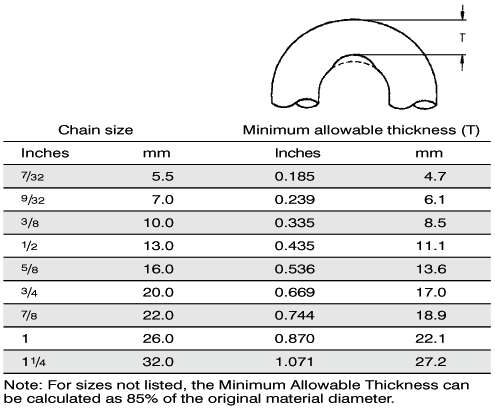|
|

| 
| |
Chain Use, Care and Inspection
| 
|
The life and strength of a chain sling or assembly depends on proper inspection, maintenance and use. For additional information, refer to ANSI B30.9 and OSHA 1910.184.
CARE
Chains require careful storage and regular maintenance.
- Store chains on an A-frame in a clean, dry place.
- To avoid corrosion, oil chains before prolonged storage.
- Do not heat chains; this will alter its thermal treatment.
- Do not plate or change surface finish of chain. For harsh environments special chain is available.
USE
To protect both operators and materials, observe these precautions when using chain slings:
- Before use, inspect chain and attachments following the instructions under "inspection" below.
- Do not exceed working load limit at any time. Any of the factors listed here can reduce the load a chain will hold.
- Acceleration in rate of load application can produce dangerous overloading.
- Variations in the angle of the load to the sling � as the angle decreases, the working load of the sling will increase.
- Twisting, knotting or kinking � subjects links to unusual loading, decreasing the working load of the sling.
- Use for purposes other than those for which slings are intended � can reduce the working load of the sling.
- Free chain of all twists, knots and kinks.
- Center load in hook(s); hook latches must not support load.
- Avoid sudden jerks when lifting and lowering.
- Balance all loads; avoid tipping of loads.
- Use pads around sharp corners.
- Do not drop load on chains.
- Match the size and working load limit of attachments, such as hooks or rings, to the size and working load limit of the chain.
- For overhead lifting, use only alloy chain and attachments grade 80 and above.
INSPECTION
It is important both to inspect chain slings regularly, and to keep records of all chain inspections. Follow this guide for such an inspection system.
- Before inspecting, clean chains with a non-acid/non-caustic solvent so that marks, nicks, wear and other defects are visible.
- Inspect each link for these conditions:
- Twists or bends.
- Nicks or gouges.
- Excessive wear at bearing points.
- Stretch.
Distorted or damaged master links, coupling links or attachments, especially spread in throat opening of hooks.
- Mark plainly with paint each link or attachment showing any of the conditions listed here to indicate rejection; remove from service until properly repaired.
WEAR ALLOWANCES OF CHAINS
Measure cross section at link ends (bearing point) to determine wear. If chain is worn to less than the minimum allowable thickness, remove from service.

USE OF CHAIN UNDER EXTREME TEMPERATURE CONDITIONS
When the chain itself is subjected to temperatures shown here, working load limits should be reduced as indicated.

• back to top •
|
| 
| 
|

